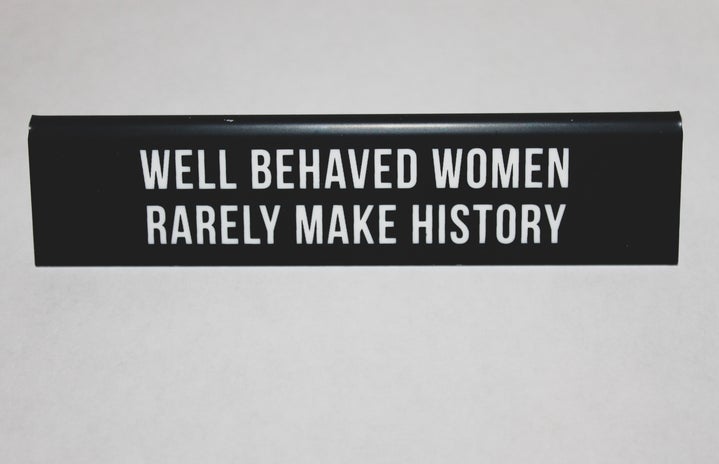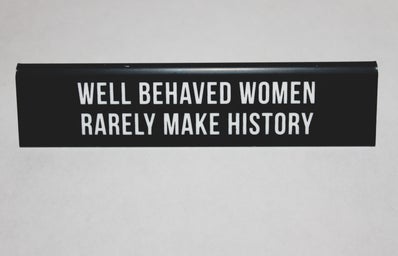To broadly restrict feminism to a set of key ideas fails to account for its ever-changing nature, ebbing and flowing through different political and social states of the world. One problem I have begun to observe lately is this close-minded approach to what a feminist must be.
When we hear that word, feminist, most will envision a woman standing strong and proud in her goals; the kind of woman who refuses to stay at home with the kids, who is inherently high-achieving and socially defiant. But to restrict ourselves to this ideal counteracts the very intention of the feminist movement, which works to encourage inclusivity for many different communities.
The first wave of feminist began as a response to a lack of voting rights, with a mass of people surging against societal norms. Gaining suffrage, women entered the field of education and began defying preconceived notions of what femininity must be.
The second wave included the “passage of the Equal Pay Act” and the “Supreme Court decisions in Griswold vs. Connecticut.” There was a growing discourse between the traditional feminist movement, which is often centered on well-off, privileged white women, and African American movements. Such tensions led to the creation of the National Black Feminist Organization, the first turn into the fully inclusive state of feminism we see today.
On a similar branch of extending missions, the third wave of feminism tackles issued within the workplace and the home, particularly related to sexual misconduct. Women during this wave of feminism, which many argue stretches to the present day, were encouraged to “express their sexuality and individuality,” values that are still alive in modern feminism.
However, after the initial feminist movement in the early 1900s, advancements underwent a period of regression which notably climaxed after the Second World War. Women began returning to the homes and “federal and civilian policies replaced women workers with men” as soon as the war concluded.
Going beyond these restrictive policies, we can infer that women began to return to domesticized work because of the period of unrest and traumatic influx. The previous societal expectations were a comfort for many who had shared a collectively damaging experience.
A woman who goes by the handle @hannahberrelli2 on TikTok recently spoke about her thoughts on the modern-day feminist movement, and she touched on this WWII phenomenon through what Betty Friedan wrote in The Feminine Mystique.
“It’s one of the books said to have really kicked off second-wave feminism,” Berrelli said in a recent video. “[Friedan]’s theory was that because people had lived through this collectively traumatizing experience, they wanted to have nice, cozy experiences of domesticity in the home.”
Education ties in closely with this theory from Friedan, as she noticed that despite women being educated and pursuing collegiate degrees, they had no outstanding desire to work. In this, we can observe the reemergence of the housewife archetype, as Berreli puts it in her video.
We have begun to see a similar thought in the 21st century, particularly spread on social media platforms like TikTok and Instagram. Women have begun publicly admitting that despite their desires and passions in younger years to learn and pursue rigorous careers, they no longer want to have careers. Instead, their goals have transitioned to valuing happiness, bodily health, and mindful perspectives. Many have started referring to this phenomenon as the ‘bimbofication’ of traditional feminism.
As Berrelli pointed out, this new wave of feminism does not conform to traditional feminist embodiments, but mirrors the transitions post-WWII.
“Haven’t we all gone through a collectively traumatizing experience recently?” Berrelli pointed out. “In March 2020, many of us thought we were going to die of a plague, [and] there’s a massive economic recession happening right now.”
In this point, Berreli illuminates the cyclical nature of this current attitude change shared by women. The shared shift in perspective should not be condemned for being anti-feminist, but should be recognized as a mirrored experience once endured by the very first feminists.
Furthering this point, Berreli shifts our focus and states that although the 1950s housewife archetype doesn’t apply to this acclaimed ‘bimbofication,’ we see the prevalence of another valued feminine image: pornographed women.
“Being a bimbo, being empty-headed, and being concerned with another kind of femininity,” Berreli said, drawing on the similarities. “Something that is a little easier and a little more comforting than thinking about the state of the world right now.”
Because of the current trauma-shift, I believe that we should collectively recognize the shortcomings of our current perspectives on feminism. The movement should never be restricted to one kind of person, but instead should broadly encompass all people.
These women regressing into a state of stability should not be condemned as any less feminist, but rather should be seen as recovering and self-soothing from a precarious outward environment. In this, we see the potential difficulties posed for the next wave of feminism.


